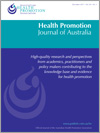
Health Promotion Journal of Australia
Volume 28 Number 3 2017
HEv28n3_EDHealth Promotion Futures
HE16107Are motivational signs to increase stair use a thing of the past? A multi-building study
Posters promoting stair use might be a thing of the past. Stair climbing is a great way to incorporate incidental physical activity into daily life and posters are often used to promote stair use; however, our work suggests that posters are ineffective. These results indicate that more interactive modes of promoting stair use may be required.
HE16107 Abstract | HE16107 Full Text | HE16107PDF (2.5 MB) | HE16107Supplementary Material (309 KB) Open Access Article
HE16036A snapshot of physical activity programs targeting Aboriginal and Torres Strait Islander people in Australia
Promoting physical activity is a promising strategy to reduce chronic disease and social disparities between Aboriginal and Torres Strait Islanders and non-Indigenous Australians. This study identified and documented 13 key aspects of physical activity programs targeting Aboriginal and Torres Strait Islander people, finding 110 current and recent programs. Examining current program practice represents an important initial step in informing future directions and evaluation.
HE16036 Abstract | HE16036 Full Text | HE16036PDF (1 MB) Open Access Article
HE16081Informing health promotion in rural men’s sheds by examination of participant health status, concerns, interests, knowledge and behaviours
Despite the mushrooming of men’s sheds in Australia in recent years, little is known about the health status, knowledge or health behaviours of shed members, particularly in rural areas. This study found that rural sheds in South Australia primarily cater for older, retired, lesser educated men from lower socioeconomic strata with one or more age-related chronic conditions and health knowledge deficits in reproductive and psychological health. GPs are the preferred source of health advice and hands-on formats for health education are preferred.
HE16017A survey of cervical screening among refugee and non-refugee African immigrant women in Brisbane, Australia
Regular cervical screening has lessened the burden of cervical cancer in developed countries; however, access to these practices is not readily available in these countries. This study examined screening practices among refugee and non-refugee women from Africa living in Brisbane. The evidence will help to develop screening interventions that meaningfully engage African immigrant women to enhance screening practices.
HE16052Barriers and facilitators to participation in workplace health promotion (WHP) activities: results from a cross-sectional survey of public-sector employees in Tasmania, Australia
It is important to better understand how organisations can maximise employee engagement in workplace health promotion (WHP). This study identified WHP implementation strategies that were associated with participation in more types of WHP activities, and the barriers associated with less participation. The findings provide evidence from the ‘real-world’ delivery of WHP by a large public-sector organisation across many different work settings.
HE16090Are regional and remote Western Australian children eating for good health? An investigation into fruit and vegetable consumption
This study used caregiver–child dyads ((n = 256) and 24-hour dietary diaries ((n = 196) to ascertain Australian Dietary Guideline (ADG) adherence among regional/remote Western Australian children. More children met fruit (65.8%) than vegetable (15.4%) recommendations, which were not impacted by remoteness. Fruit and vegetable types and varieties significantly differed between regional/remote locations.
HE16095Achieving equity in Crunch&Sip®: a pilot intervention of supplementary free fruit and vegetables in NSW classrooms
In NSW primary schools, classroom breaks for children to consume fruit or vegetables and drink water rely on parental provision of produce. This pilot intervention showed that provision of free produce to previously non-participating children was required to ensure equitable reach of the C&S program.
HE16075Outdoor gyms and older adults – acceptability, enablers and barriers: a survey of park users
Increasing physical activity will assist older adults to maintain and improve their health. The availability of outdoor gyms in Australia is increasing. This research establishes whether outdoor gyms are an acceptable form of physical activity for older adults. Results indicate that older adults will use outdoor gyms with a variety of equipment and shade.
HE16119Cyclists’ perceptions of motorist harassment pre- to post-trial of the minimum passing distance road rule amendment in Queensland, Australia
Cyclists’ perceptions of harassment by motorists discourages cycling. This study compared the percentage of cyclists reporting harassment pre- to post-introduction of a minimal passing distance road rule amendment. The study found that cyclists continued to perceive harassment by motorists after the road rule was introduced, which indicates that minimum passing distance rules may not improve cyclists’ perceptions of motorists’ behaviours.
HE16082Nurse provision of support to help inpatients quit smoking
Smoking has been linked to an increased risk for cancers and cardiovascular disease. This study engaged hospital nurses to find out why routine smoking cessation care was not provided. Nurses did not have confidence in their knowledge and skills in smoking cessation to support patients to quit smoking. Education and training in smoking cessation best practice should be available to all nursing staff.
HE16085Changes in smoking, drinking, overweight and physical inactivity in young Australian women 1996–2013
Smoking, risky drinking, overweight and obesity, and inadequate physical activity increase the risk of poor health. In the last two decades, only smoking has decreased significantly (but not among less educated women), while overweight and obesity has increased in all groups of young women. Although smoking interventions have been successful, weight control measures among young women have been futile.

